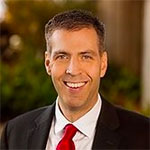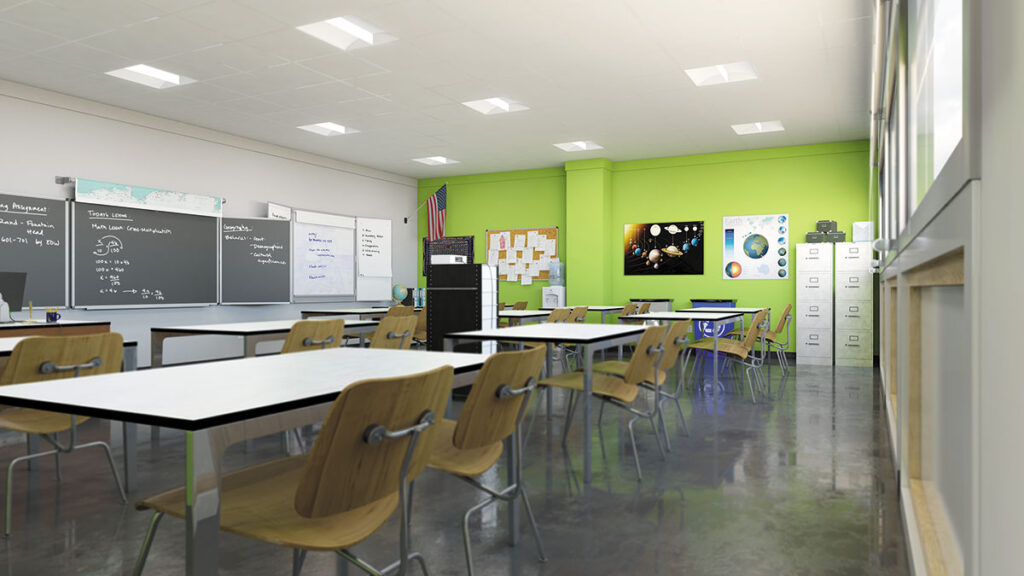From kids to codes to connectivity, here are five things lighting professionals should keep top of mind to improve educational facilities
By Chris Andrews
Today’s school lighting works harder and smarter than ever before. Because educational facilities want lighting solutions that not only help them provide an attractive and comfortable learning environment—educational facilities are also interested in lighting solutions that support their school’s more complex challenges. Whether it’s a small elementary school or a college or university, whether you’re working on a major campus-wide lighting upgrade or you’re starting with just a few classrooms, here are five things you should keep in mind, starting with perhaps the most compelling.
1 Remember that lighting can improve student performance. Lighting is a critical element in the school environment. Not just for visual comfort and safety, but for influencing behavior, task performance, and psychological and emotional responses.1 Lighting controls that incorporate color tuning capabilities allow schools to match the color temperature of the lighting in a space with its application needs (Figure 1).
For example, schools may choose a bright cool white light for their science labs to help students stay alert and better focus on their lessons. For the cafeteria, the school may choose a soft warm white that may reduce stress, help students relax and discourage disruptive behavior.

2 Be prepared for lighting codes that are especially complex. The codes you must follow when designing lighting for educational facilities typically change every few years. They differ by town, county and state. There are specific lighting regulations for each of the different spaces in an educational facility as well as the tasks performed in those spaces. To help make sense of the codes, there are three resources for regulations and standards affecting lighting design that you may find very useful:
- ASHRAE/ANSI/IES 90.1-2019 aligns with U.S. Department of Energy requirements and judges primarily based on a lumen power density (LPD) approach.
- IECC 2021 (International Energy Conservation Code 2021) is the most common code in the U.S. and prescribes requirements for luminaire level lighting controls.
Keep in mind that there are states and particular geographies that selectively apply their own codes or versions of the two energy codes above.
ANSI/IES RP-3-20: Lighting Educational Facilities includes application-specific Recommended Practices (RP) specific to the education space that help designers achieve the best results.
3 Meet with the people who work in the educational facilities. There’s no better way to get insight into how a space is used than to talk to the people who are closest to it: school board members, deans and educators. Informal, unscripted conversations will provide you with the kind of first-hand information that will help you determine what challenges need to be addressed—and they may help you uncover opportunities that hadn’t been apparent before. What’s more, involving the people who work in the facilities in the design process gives them agency and helps secure their ongoing support for the lighting project.
4 Consider germicidal UV (GUV) light as a disinfectant. The past few years have made many of us more germ-conscious. Expect GUV to be a part of most conversations about improving educational facilities. How does GUV lighting work to disinfect? First of all, GUV light is an effective way to inactivate viruses. (Viruses are not living organisms, so they can’t be killed, only inactivated.) Specifically, the energy within a particular range of ultraviolet light destroys the nucleic acids within a virus, altering the structure of its RNA, which in turn inactivates the virus.
Before COVID-19, GUV had already been used for many years to clean the air passing through the HVAC system. This GUV lighting strategy was considered the safest, but also the least effective GUV option. With the global pandemic, additional GUV lighting strategies have evolved. Upper air, for example, can be safe if the operating instructions are followed precisely; otherwise, unintended harm to the eyes may result. Likewise, surface and portable disinfection are fast, effective options, however, both require the space to be unoccupied and can be dangerous without safeguards.
As an extra precaution, whenever safety is a concern, Underwriters Laboratories (UL) certification should be on your must-have list. UL has established safety standards for all kinds of hardware and applications. UL’s safety standards for germicidal UV systems are broken down into two categories: for upper air inactivation, UL1598 luminaire standard applies, and for disinfecting rooms, UL8802 applies.
5 Evaluate connected lighting and RTLS for safety and security opportunities. Connected lighting includes a dense network of digital sensors to support code compliance, energy savings and a good return on investment (ROI). In addition, connected lighting can take a code-compliant school beyond lighting energy savings to an entirely new level of efficiency. Because those same digital sensors can also be used to collect location information and combined with RTLS (Real-Time Location System) technology to result in better utilized spaces, improved student and staff safety, more efficient asset utilization, and more reliable contact tracing all become possible.
Here are some examples of ways education facilities are already counting on connected lighting and RTLS technology to increase safety and security in their buildings and on their campuses:
- School-issued ID cards embedded with RTLS technology allow schools to limit access to buildings and other areas to authorized people only.
- The system can count the number of occupants in a room and compare it to the number of authorized occupants (that is, valid ID cards in the room); if the numbers don’t match, an alert is issued.
- In the event of a natural disaster or security threat, the system allows the administration to instantly determine the precise location of every student.
- The system can be used to count the number of students using the library, student lounge or any other area to help best allocate space based on student needs.
- If a piece of school equipment is taken out of the building without authorization, an alert immediately notifies the security officer.
- In the event of an infectious disease outbreak, the system can be used for speedy and reliable contact tracing to contain the spread of illness.
Be sure to take cybersecurity seriously. Protect your connected system and thwart attacks by following best practices and looking for products that meet cybersecurity standards that are independently tested. UL2900 standards are one of the most notable in the U.S. covering network connected devices with scope limited to North America. Another internationally recognized standard is the International Electrotechnical Commission (IEC) 62443 standard. It addresses not only the technology, but the processes, countermeasures, and the employees as a risk-based approach. Both UL and IEC can be independently verified and, unlike a safety certification, listing is on an annual basis as threats are constantly evolving.
As lighting engineers, we can offer educational facilities so many opportunities to improve the comfort, performance and safety of their students and staff.
References
1 https://link.springer.com/chapter/10.1007/978-981-15-7383-5_1


